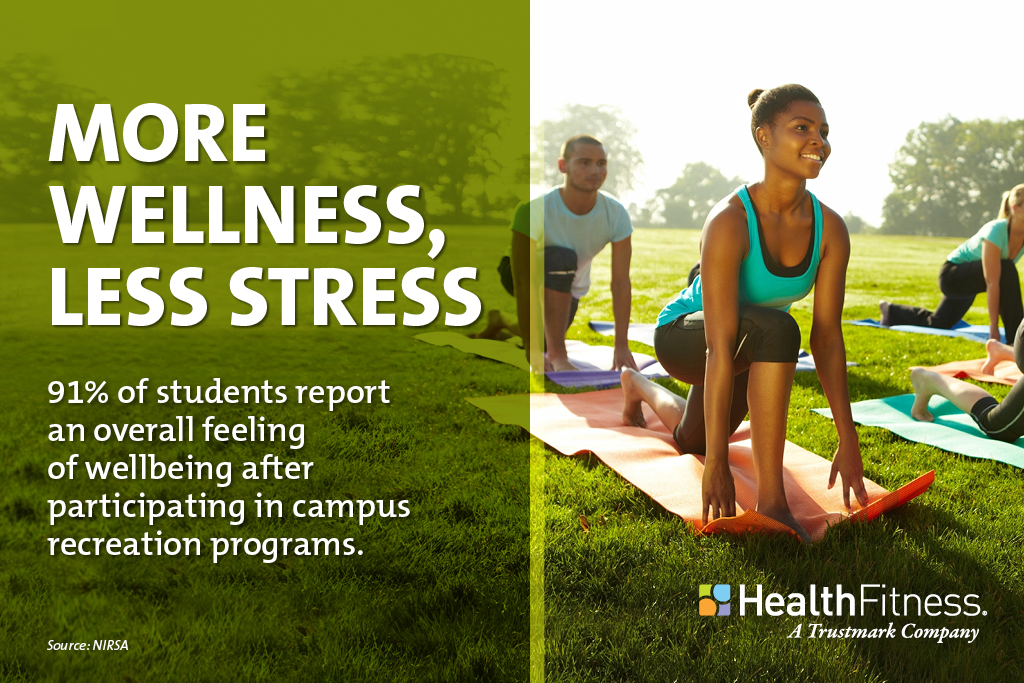HealthFitness
Published by Tim Mertz on June 12th, 2019
At HealthFitness, we believe total wellbeing matters. Our tenure as one of the largest providers of recreation and wellness center management programs in the country ensures we can get (and keep) your campus community moving and engaged in their health and wellbeing.
When you consider that 75% of college students use on-campus recreation facilities, programs and services—and 80% of those students participate at least once a week—it is more important than ever to provide a recreation and wellness center with programs and services designed around students. (1)

A growing number of colleges and universities are making tremendous strides toward integrating wellbeing throughout their campus communities. According to NIRSA, the top health and wellness benefits students attribute to their participation in campus recreation facilities and programs include:
Whether it's enhancing a student’s quality of life while on campus, supporting increased physical activity through social and engaging programs, or providing informative wellness-related programs for students—here are six ways HealthFitness works directly with colleges to incorporate recreation and wellness solutions that impact total campus health and the student life experience.
1. Develop cross-campus collaborations
We believe that no one department on campus should own wellness, but rather, we advocate for cross-campus collaborations and an effective outreach model that amplifies your wellness-related resources to engage students, faculty and staff.
Our HealthFitness team manages campus recreation for the Massachusetts Institute of Technology (MIT) and takes a leadership role in helping MIT embrace integrated wellness. This is due to our team’s ability to help develop more than 100 cross-campus partnerships that include events such as open houses for students with disabilities, campus-wide fitness challenges, nutrition workshops and massage.
2. Enjoy a Dive-In movie
Working in collaboration with colleagues at MIT’s substance-free office, the MIT Recreation team creates activities around high-risk weekends, such as right before class starts, when there’s a greater potential for alcohol or drug abuse. One such example was a Dive-In Movie Night, where students floated in the 50-meter pool on inner tubes while watching Moana and Finding Dory on the digital scoreboard.
3. Offer mindfulness programming
Our MIT Recreation team partners with MIT instructors to factor neuroscience into a yoga class called Neuroflow, where participants are guided through a combination of lecture and exercises, designed to link meditation and yoga to their effect on the body and mind. Neuroflow features discussion on neuroanatomy, the senses, motor systems, anxiety, and why the first two hours after we move are so critical.
4. Pot a plant
Our team at Harvard Recreation use creative ways to help students find time for recreation—whether it’s inside their houses (dorms), at the recreation center, or throughout the community. They make it a priority to visit each house on the Harvard University campus and provide wellbeing programming to students. Activities include tie dye nights, painting, and potting and plant night—one of the most popular activities.
Our team purchases succulents, potting soil, colorful rocks, moss, and fish bowls—everything students need to get their hands dirty and be creative. Students enjoy the experience because the potted plant is something tangible they can put in their rooms. A succulent is easy to take care of—even if they forget to water it!
5. Sponsor large-scale campus-wide events
Our team at Harvard Recreation provides wellness support for large campus events, including 5Ks, outdoor boot camps, yoga and DJ-hosted Zumba events. They also partner with Harvard’s Wellness Center to offer their services for mindfulness classes, sleep, yoga, meditation and massage. Large events at MIT include an indoor triathlon, cornhole, badminton, and dodge ball tournament. The events help create awareness about recreation and lets the students know we are there to support them.
6. Take a study break
Each semester Harvard students participate in a reading period where they have one week off of classes before finals week. Prior to the reading period, classes, clubs and intramural participation conclude and the week is entirely dedicated to reading and studying for finals. Our Harvard Recreation team provides wellness study breaks, group exercise, massage chairs—anything to give students a moment away from their books.
Source:
1. Forrester, S. (2014). The Benefits of Campus Recreation. Corvallis, OR: NIRSA.
When you consider that 75% of college students use on-campus recreation facilities, programs and services—and 80% of those students participate at least once a week—it is more important than ever to provide a recreation and wellness center with programs and services designed around students. (1)

A growing number of colleges and universities are making tremendous strides toward integrating wellbeing throughout their campus communities. According to NIRSA, the top health and wellness benefits students attribute to their participation in campus recreation facilities and programs include:
- Feeling of wellbeing: 91%
- Overall health: 91%
- Fitness level: 90%
- Physical strength: 89%
- Stress management: 86%
Whether it's enhancing a student’s quality of life while on campus, supporting increased physical activity through social and engaging programs, or providing informative wellness-related programs for students—here are six ways HealthFitness works directly with colleges to incorporate recreation and wellness solutions that impact total campus health and the student life experience.
1. Develop cross-campus collaborations
We believe that no one department on campus should own wellness, but rather, we advocate for cross-campus collaborations and an effective outreach model that amplifies your wellness-related resources to engage students, faculty and staff.
Our HealthFitness team manages campus recreation for the Massachusetts Institute of Technology (MIT) and takes a leadership role in helping MIT embrace integrated wellness. This is due to our team’s ability to help develop more than 100 cross-campus partnerships that include events such as open houses for students with disabilities, campus-wide fitness challenges, nutrition workshops and massage.
2. Enjoy a Dive-In movie
Working in collaboration with colleagues at MIT’s substance-free office, the MIT Recreation team creates activities around high-risk weekends, such as right before class starts, when there’s a greater potential for alcohol or drug abuse. One such example was a Dive-In Movie Night, where students floated in the 50-meter pool on inner tubes while watching Moana and Finding Dory on the digital scoreboard.
3. Offer mindfulness programming
Our MIT Recreation team partners with MIT instructors to factor neuroscience into a yoga class called Neuroflow, where participants are guided through a combination of lecture and exercises, designed to link meditation and yoga to their effect on the body and mind. Neuroflow features discussion on neuroanatomy, the senses, motor systems, anxiety, and why the first two hours after we move are so critical.
4. Pot a plant
Our team at Harvard Recreation use creative ways to help students find time for recreation—whether it’s inside their houses (dorms), at the recreation center, or throughout the community. They make it a priority to visit each house on the Harvard University campus and provide wellbeing programming to students. Activities include tie dye nights, painting, and potting and plant night—one of the most popular activities.
Our team purchases succulents, potting soil, colorful rocks, moss, and fish bowls—everything students need to get their hands dirty and be creative. Students enjoy the experience because the potted plant is something tangible they can put in their rooms. A succulent is easy to take care of—even if they forget to water it!
5. Sponsor large-scale campus-wide events
Our team at Harvard Recreation provides wellness support for large campus events, including 5Ks, outdoor boot camps, yoga and DJ-hosted Zumba events. They also partner with Harvard’s Wellness Center to offer their services for mindfulness classes, sleep, yoga, meditation and massage. Large events at MIT include an indoor triathlon, cornhole, badminton, and dodge ball tournament. The events help create awareness about recreation and lets the students know we are there to support them.
6. Take a study break
Each semester Harvard students participate in a reading period where they have one week off of classes before finals week. Prior to the reading period, classes, clubs and intramural participation conclude and the week is entirely dedicated to reading and studying for finals. Our Harvard Recreation team provides wellness study breaks, group exercise, massage chairs—anything to give students a moment away from their books.
1. Forrester, S. (2014). The Benefits of Campus Recreation. Corvallis, OR: NIRSA.
